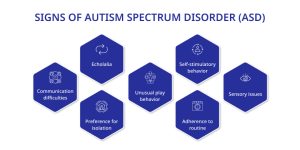Autism is one of the complicated neuro-developmental disorder that requires a multi-faceted approach to intervention. Children with autism commonly face specific obstacles that influence their general development and daily lives. The best occupational therapy approaches must be used in conjunction with behavioral therapy in order to effectively treat the key symptoms of autism. A number of benefits of paediatric occupational therapy are valuable for autistic children to build bridges for their better future.
Therefore, CogniAble team applies Paediatric occupational therapy that combines with Behavioral therapy and occupational therapy to offer comprehensive support to the children by identifying a range of areas which require development. While occupational therapy adopts a holistic approach to improve a child’s functional capacity and independence, behavioral therapy places a stronger emphasis on treating behaviors, communication, and interactions with others. The best occupational therapy for autism is provided by CogniAble with a goal to encourage children’s maximum development and mobility.
Many autistic children struggle with sensory processing, which can result in sensory sensitivity or seeking behaviours. Occupational therapists at CogniAble, with a focus on paediatrics are qualified to identify and treat these difficulties. Through the use of sensory integration techniques, CogniAble therapists:

Paediatric occupational therapists in CogniAble use strategies that have been proven to be successful for children with autism while staying informed about the most recent research. Another crucial component of occupational therapy for autistic children is the development of motor skills. The best occupational therapy methods used by CogniAble emphasize on enhancing both fine and gross motor abilities in children with autism. While gross motor skills cover larger actions like running or jumping and balance, fine motor skills cover simpler movements such as buttoning, writing with hands, and carrying small items.
To improve motor skills, coordination, and strength, paediatric occupational therapists at CogniAble employ:
These developments enable kids to engage more fully in self-care, promoting their independence and self-assurance. Apart from this, CogniAble recognizes the importance of collaboration and coordination among various professionals involved in a child’s development. The team works along with other experts, such as educators, behavioral therapists, and speech therapists, to make sure the child’s development is coordinated and integrated. This cooperation fosters intervention consistency across many contexts and improves the child’s development and general wellbeing.
Pediatric OTs look at how you do any kind of activity or task. Then come up with a plan to improve the way
you do it to make it easier or less painful. They use a variety of techniques and tools, such as sensory
integration therapy, play-based therapy, fine motor skill development, and adaptive equipment to help
children achieve their goals.
OTs skills or aspects that allow the child to perform these “jobs”:
• Motor Development and Motor Planning
• Feeding and Oral Motor skills
• Cognitive Development
• Visual Processing skills
• Sensory processing
• Self-regulation
• Social and emotional skills
• Emotional-regulation
• Social participation
• Executive functioning skills- organization, attention, working memory, planning, prioritization,
impulse control, and other skills
• Fine and gross motor skills
• Safety in the home and community
• Balance and coordination
With OT, kids can:
• Develop fine motor skills so they can grasp and release toys and develop good handwriting or
computer skills.
• Improve eye–hand coordination so they can play and do needed school skills such as bat a ball and
copy from a blackboard.
• Learn basic life skills such as bathing, getting dressed, brushing teeth, and self-feeding.
• Learn positive behaviors and social skills by practicing how they manage frustration and anger.
• improve attention and social skills to allow the development of interpersonal relationships.
Occupational therapists always strive to be evidence-based and client-centered in their practice. This means
that whatever assessments and treatments they use with your child are backed by research and experience
(evidence-based) and are specifically geared toward your child’s interests and needs.
Teaching writing to kids with autism can be a challenging task. Children with autism often have difficulties with communication and social interactions, and these challenges can extend to writing. However, with the right approach and strategies, it is possible to help these kids develop their writing skills and express themselves in written form.
In this article, we will explore some effective ways to teach writing to kids with autism:
Don’t jump to teaching writing directly make sure to work on should strengthening, elbow strengthening, wrist movement, and fine motor skills. These are basics that a child should master before introducing writing to the child.
Writing can be overwhelming for some children with autism. To make it less intimidating, break down the writing process into smaller, more manageable steps. For example, start by teaching them how to scribble in a restricted area then trace standing and sleeping lines then trace curved and zig-zag lines, and lastly trace alphabets with standing, sleeping, and slanting lines like ( AEFHIKLMNTVWXYZ) then alphabets with curves like ( BCDJOPQRSU) first upper case and then lower case. After tracing teaching copying, where a sample is presented and the learner has to copy. Then transcription is when the learner is said to write and the learner follows instructions.
Teaching writing should be made fun using a multisensory approach, teaching should not be done traditionally on paper with a pen, use earbuds, paint, paintbrush, kinetic sand, and another stimulating mode for writing material keeping the sensory need of a child in mind. Use textured paper (rough, smooth), tearing and pasting, blow paint, water paints, etc.
If the learner does not have a good relationship with writing, focus on making writing fun for leaner. Don’t do many trials, start with one alphabet writing it only one time eventually after week 2 trials then after that trials should increase
Technology can be a powerful tool when teaching writing to kids with autism. There are several writing software programs that can help them with writing. Apps like writing success, letter school, I–trace, Narrator – AR, etc.
Positive reinforcement can be an effective way to encourage children with autism to write. Praise them for their efforts and celebrate their accomplishments. You can also use rewards, such as stickers or a special activity, to motivate them to write.
Always sit behind the child to prompt physically by holding the hand providing full physical prompt and eventually fading by moving the hand back toward the elbow and then eventually to the shoulder.
Teaching writing to kids with autism can be a slow process, and it is important to be patient. Give them time to process information and express themselves. Allow them to work at their own pace, and do not put too much pressure on them. With time and practice, they will improve their writing. Practice daily but not too much also.
When a child is still beginning to write, it can help to have an adult model it. Write large letters in highlighter, and have your child trace them in pencil or pen. Let them connect the dots. Draw dots in the shape of a letter.
In conclusion, teaching writing to kids with autism can be a challenging task, but it is not impossible. By using visuals, breaking down the writing process, providing visual prompts, using technology, allowing for creativity, using positive reinforcement, and being patient, you can help these children develop their writing skills and express themselves in written form. Remember, every child is unique, and what works for one child may not work for another. It is essential to tailor your teaching approach to the child’s individual needs and abilities.
Autism Spectrum Disorder (ASD) is a developmental neurological disorder that affects the brain’s normal functioning, leading to difficulties in social interaction and communication. The term “spectrum” is used to describe the wide variation in the type and severity of symptoms observed in individuals with ASD. Some children may be on the non-verbal end of the spectrum, communicating their needs through gestures or pointing. Others may be on the verbal end, repeating words or sentences, but still require varying degrees of assistance in social settings.

Few tell tale signs of ASD –
1. Communication difficulties: Is your child struggling to express their needs or communicate effectively with others?
2. Echolalia: Does your child repeat words or phrases over and over again?
3. Preference for isolation: Does your child prefer to play alone rather than with peers?
4. Unusual play behavior: Have you noticed your child engaging in atypical play behaviors, such as lining up toys?
5. Self-stimulatory behavior (stimming): Does your child engage in repetitive motor movements, such as hand-flapping or rocking?
6. Adherence to routine: Does your child become upset when certain tasks are not done in a particular way or at a specific time?
7. Sensory issues: Does your child exhibit hypersensitivity or hyposensitivity to certain sensory inputs, such as touch, sound, taste, or visual stimuli?
It’s important to note that every child with ASD is unique and will exhibit a range of symptoms and behaviors. Understanding your child’s specific needs and seeking professional support can greatly enhance their quality of life and help them reach their full potential.
Parents and caregivers of children with Autism Spectrum Disorder (ASD) can greatly benefit from seeking professional support such as speech therapists, occupational therapists, and behavioral therapists to help manage the symptoms of the disorder. However, it’s equally important for parents and caregivers to educate themselves about ASD and learn how to support their child’s unique needs. This may involve making adaptations in the home environment to accommodate the child’s needs and finding alternative ways to communicate their needs. Additionally, connecting with other families and support groups who have experience with ASD can provide valuable insight and guidance. By taking a holistic approach to supporting their child with ASD, parents, and caregivers can help their child thrive and reach their full potential